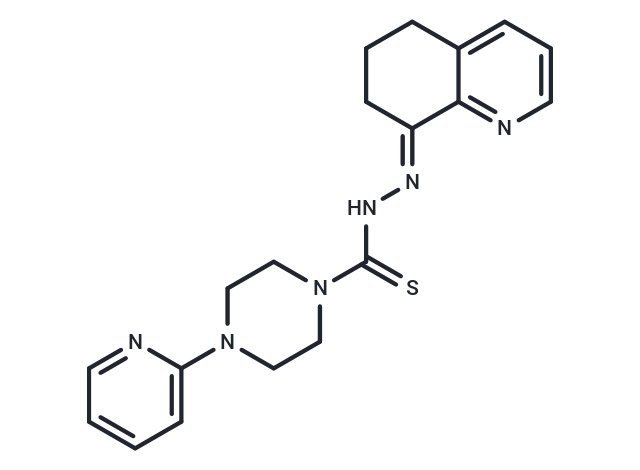Shopping Cart
- Remove All
 Your shopping cart is currently empty
Your shopping cart is currently empty

COTI-2, an orally available thiosemicarbazone, is an activator of mutant forms of the p53 protein with potential antineoplastic activity.

| Pack Size | Price | Availability | Quantity |
|---|---|---|---|
| 5 mg | $38 | In Stock | |
| 10 mg | $63 | In Stock | |
| 25 mg | $116 | In Stock | |
| 50 mg | $173 | In Stock | |
| 100 mg | $293 | In Stock | |
| 200 mg | $423 | In Stock | |
| 1 mL x 10 mM (in DMSO) | $44 | In Stock |
| Description | COTI-2, an orally available thiosemicarbazone, is an activator of mutant forms of the p53 protein with potential antineoplastic activity. |
| In vitro | COTI-2 (72 h) potently inhibits the proliferation rate of all the tested cell lines. In COLO-205, HCT-15, and SW620 cell lines, COTI-2 markedly inhibits tumor cell proliferation. Relatively low concentrations of COTI-2 are active against all human glioblastoma cell lines tested (U87-MG, SNB-19, SF-268, and SF-295). In SHP-77 cells, COTI-2 treatment with IC50 concentrations causes the induction of early apoptosis among 40 to 47% of total cells. |
| In vivo | In the HT-29 human colorectal tumor xenografts, COTI-2 (10 mg/kg) markedly inhibits tumor growth. Except for reducing tumor volumes at specific times post-treatment, COTI-2 also increases the time required for tumors to reach specified volumes. In the SHP-77 SCLC xenograft model, COTI-2 (3 mg/kg) also markedly inhibits tumor growth. COTI-2 can reduce U87-MG tumor volumes at specific times post-treatment and lengthen the time required for U87-MG xenografts to grow in nude mice. Control tumors in mice treated with vehicle alone take only 5 days to reach an average volume of 828 mm3 while tumors in animals treated with COTI-2 take double that time (10 days) to reach a similar mean volume (857 mm3). Regardless of the route of administration, COTI-2 potently inhibits OVCAR-3 xenograft growth. |
| Kinase Assay | The interaction of COTI-2 with 227 kinases is tested using the AMBIT BIOSCIENCES KINOMESCAN assay. In brief, streptavidin-coated magnetic beads are treated with biotinylated small molecule ligands for 30 min at 25°C to generate affinity resins for kinase assays. The liganded beads are blocked with excess biotin and washed with blocking buffer (1% BSA, 0.05% Tween 20, 1 mM DTT) to remove unbound ligand and to reduce non-specific binding. Binding reactions are assembled by combining phage lysates, liganded affinity beads, and COTI-2 in 1× binding buffer (20% SeaBlock, 0.17× PBS, 0.05% Tween 20, 6 mM DTT). All reactions are carried out in polystyrene 96-well plates that have been pre-treated with blocking buffer in a final volume of 0.1 mL. |
| Cell Research | COTI-2 is dissolved in 100% dimethyl sulfoxide stock solution and diluted in medium plus FBS such that final DMSO concentrations are 0.5 to 1.0% depending on the experiment.SHP-77 cells are cultured with various concentrations of COTI-2 for 48 h. Cells are then washed twice with 1× cold PBS and stained with Annexin V and 7AAD according to the manufacturer's instructions. Briefly, 5 μL of Annexin V and 7AAD are added to 1×105 cells and incubated for 15 min at room temperature in the dark. Then 400 μL of the 1× binding buffer (100 mM HEPES, pH 7.4, 140 mM NaCl, 2.5 mM CaCl2) is added to the cells. Finally, cells are analyzed using a flow cytometer. |
| Animal Research | SHP-77 and HT-29 cells are injected in 50% matrigel into flanks of NCr-nu mice (2×106 cells per injection site) (n=5 mice per group). In the case of SHP-77 xenografts, treatment with COTI-2 begins prior to the appearance of palpable tumors. One day after injection of SHP-77 cells, animals receive 3 mg/kg of COTI-2 (once every two days, up to 38 days). Tumor sizes are estimated at 5, 10, 17, 24, and 38 days, by standard caliper measurements. In the case of HT-29 xenografts, the capacity of COTI-2 to suppress the growth of established tumors is assessed. HT-29 xenografts are allowed to grow to 200 mm3 before starting IP treatment with COTI-2 (10 mg/kg, 5 days a week for 7 weeks) or saline IP. Tumor growth is measured every 4 days by caliper measurement. |
| Alias | COTI2, COTI 2 |
| Molecular Weight | 366.48 |
| Formula | C19H22N6S |
| Cas No. | 1039455-84-9 |
| Smiles | S=C(N\N=C1/CCCc2cccnc12)N1CCN(CC1)c1ccccn1 |
| Relative Density. | no data available |
| Storage | Powder: -20°C for 3 years | In solvent: -80°C for 1 year | Shipping with blue ice. | ||||||||||||||||||||
| Solubility Information | DMSO: 5 mg/mL (13.64 mM) | ||||||||||||||||||||
Solution Preparation Table | |||||||||||||||||||||
DMSO
| |||||||||||||||||||||

Copyright © 2015-2024 TargetMol Chemicals Inc. All Rights Reserved.